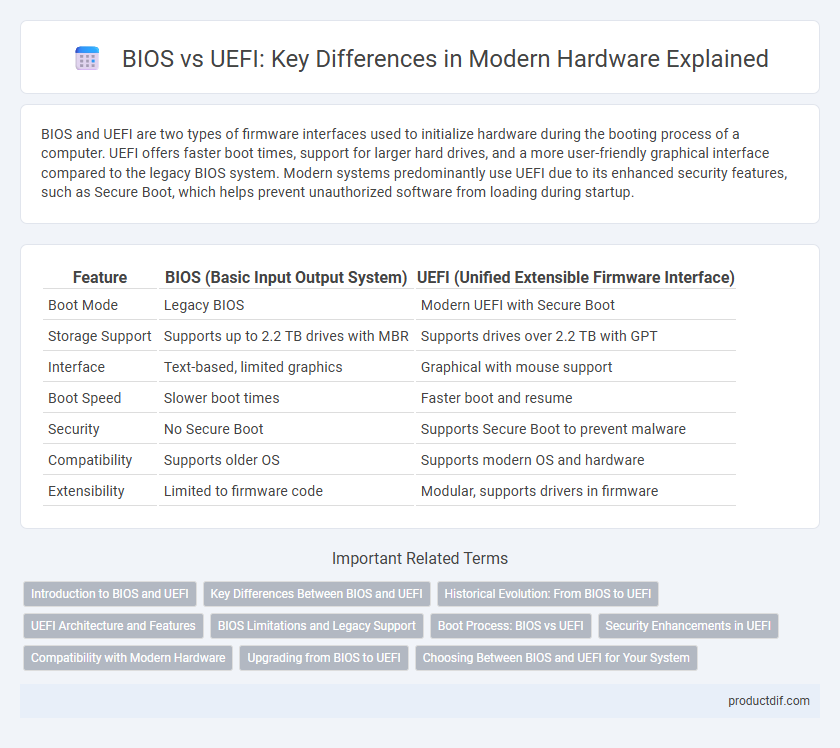BIOS and UEFI are two types of firmware interfaces used to initialize hardware during the booting process of a computer. UEFI offers faster boot times, support for larger hard drives, and a more user-friendly graphical interface compared to the legacy BIOS system. Modern systems predominantly use UEFI due to its enhanced security features, such as Secure Boot, which helps prevent unauthorized software from loading during startup.
Table of Comparison
| Feature | BIOS (Basic Input Output System) | UEFI (Unified Extensible Firmware Interface) |
|---|---|---|
| Boot Mode | Legacy BIOS | Modern UEFI with Secure Boot |
| Storage Support | Supports up to 2.2 TB drives with MBR | Supports drives over 2.2 TB with GPT |
| Interface | Text-based, limited graphics | Graphical with mouse support |
| Boot Speed | Slower boot times | Faster boot and resume |
| Security | No Secure Boot | Supports Secure Boot to prevent malware |
| Compatibility | Supports older OS | Supports modern OS and hardware |
| Extensibility | Limited to firmware code | Modular, supports drivers in firmware |
Introduction to BIOS and UEFI
BIOS (Basic Input/Output System) is firmware that initializes and tests hardware components during the booting process, providing a low-level interface between the operating system and hardware. UEFI (Unified Extensible Firmware Interface) is a modern replacement for BIOS, offering faster boot times, enhanced security features like Secure Boot, and support for drives larger than 2.2 TB with a flexible, modular design. Both BIOS and UEFI control system startup, but UEFI's advanced architecture enables improved user interfaces and greater compatibility with contemporary hardware standards.
Key Differences Between BIOS and UEFI
BIOS (Basic Input/Output System) is firmware that initializes hardware during the boot process and relies on MBR (Master Boot Record) partitioning, supporting up to 2TB drives, whereas UEFI (Unified Extensible Firmware Interface) uses GPT (GUID Partition Table) allowing support for drives larger than 2TB and faster boot times. UEFI offers a graphical interface and network capability, enabling remote diagnostics and repair, contrasting with BIOS's text-based interface and limited functionality. Security features like Secure Boot are integrated into UEFI, providing enhanced protection against malware during startup, which BIOS lacks.
Historical Evolution: From BIOS to UEFI
The transition from BIOS (Basic Input/Output System) to UEFI (Unified Extensible Firmware Interface) marks a significant advancement in firmware technology, beginning in the 1980s with BIOS offering basic startup instructions and hardware initialization. UEFI, developed in the mid-2000s by the Unified EFI Forum, provides enhanced features such as faster boot times, support for larger hard drives over 2.2 TB, and a modular design allowing for drivers and applications to run before the OS loads. This evolution addresses the limitations of BIOS, enabling modern hardware compatibility, user-friendly interfaces, and improved security measures like Secure Boot.
UEFI Architecture and Features
UEFI architecture includes a modular design with drivers stored in the firmware, allowing faster boot times and enhanced hardware compatibility compared to BIOS. It supports a graphical user interface and mouse input, enabling easier configuration and management. Secure Boot, a key UEFI feature, protects the system against unauthorized firmware and software during startup.
BIOS Limitations and Legacy Support
BIOS is limited by a 16-bit processor mode and 1 MB addressable memory space, restricting modern hardware performance and large storage device compatibility. Legacy BIOS lacks support for drives larger than 2.2 TB and cannot utilize advanced features like secure boot or fast startup. Despite these constraints, BIOS remains relevant due to widespread legacy hardware and software dependencies.
Boot Process: BIOS vs UEFI
The boot process in BIOS involves executing the POST (Power-On Self-Test) and then loading the Master Boot Record (MBR) from the first sector of the bootable disk to initiate the operating system. In contrast, UEFI uses a more advanced method by reading the EFI system partition and loading executable files defined by the firmware, offering faster startup times and support for drives larger than 2TB. UEFI also provides a more flexible pre-boot environment with direct access to hardware, secure boot capabilities, and a graphical interface compared to BIOS's text-based interface.
Security Enhancements in UEFI
UEFI offers advanced security enhancements compared to traditional BIOS, including Secure Boot, which prevents unauthorized operating systems and malware from loading during the boot process. Its support for cryptographic signatures verifies the integrity and authenticity of bootloaders, reducing vulnerabilities to rootkits and bootkits. UEFI's modular firmware architecture allows for regular updates and security patches, improving overall system protection against emerging threats.
Compatibility with Modern Hardware
UEFI offers enhanced compatibility with modern hardware by supporting larger hard drives over 2 TB, faster boot times, and advanced security features like Secure Boot that BIOS lacks. BIOS operates on legacy firmware designed for older hardware architectures, limiting its ability to fully utilize current processors and storage technologies. Modern motherboards predominantly feature UEFI to ensure seamless integration with contemporary CPUs, SSDs, and peripherals.
Upgrading from BIOS to UEFI
Upgrading from BIOS to UEFI enhances system performance and security by supporting larger hard drives, faster boot times, and secure boot features that protect against malware. UEFI firmware provides a modern interface, improved hardware compatibility, and better support for advanced technologies like GPT partitions and network booting. Transitioning requires ensuring motherboard compatibility and backing up data, as the switch may involve reformatting drives and updating system settings.
Choosing Between BIOS and UEFI for Your System
When choosing between BIOS and UEFI for your system, consider UEFI's faster boot times, support for drives larger than 2TB, and enhanced security features like Secure Boot. BIOS remains compatible with older hardware and simpler interfaces, making it suitable for legacy systems. Opt for UEFI to leverage modern hardware capabilities, improved firmware interfaces, and greater flexibility in system configuration.
BIOS vs UEFI Infographic

 productdif.com
productdif.com